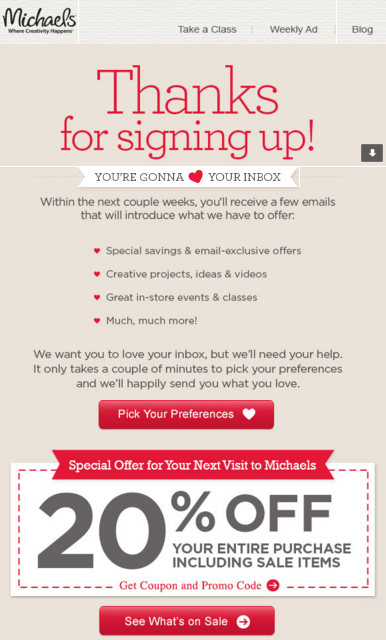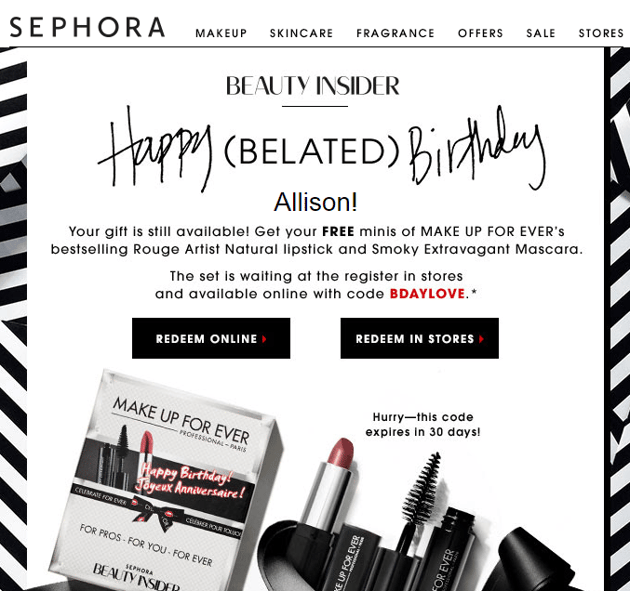3-Step Guide to Celebratory Email Marketing

There are many things people look forward to on their birthdays, but not all of them include candles or gift wrap.
Birthday emails, for example, are one of the unexpected surprises that most consumers find in their inbox on or around their special day. While some of these well-wishing emails come from close friends and family, most typically come from the consumer's favorite businesses and brands - and for good reason. According to data from Experian Marketing Services, birthday emails receive 179 percent higher unique click rates than promotional emails, 342 percent higher revenue per email and 481 percent higher transaction rates.
In order to reap the rewards from this marketing tactic, however, brands must not only collect the right information from their email subscribers, but also put a marketing plan together for this initiative. For some inspiration, check out Website Magazine's 3-step guide to special day email marketing below:
Step 1: Collect Information
In order to implement a birthday email marketing plan, marketers must first collect the birth dates of their subscribers. As most marketers know, collecting this type of personal information can be challenging.
One way to collect birthday information is by asking subscribers when they sign up for an email list. Although some sign-up forms simply require consumers to enter their email address, marketers can create a short form that asks subscribers for additional information, such as their first and last name, birth date, gender and shopping preferences. What's more, marketers can offer incentives to new subscribers in exchange for this information. Adidas, for instance, asks new subscribers to enter their date of birth and gender when signing up for its newsletters. In order to motivate subscribers to fill out these questions the retailer offers incentives, including a 15% off voucher, as well as access to special deals, offers and news.

Another way marketers can collect birth date information is by asking subscribers for this data after they have already signed up for a newsletter. This can be done by sending out a welcome email that thanks the subscriber for signing up for newsletters and includes a link to a form that subscribers can fill out when they have time.

It is important to note that marketers who want to collect birthday information from current subscribers can take a similar approach to Michaels (shown above). Instead of sending a welcome email, however, marketers should simply send out an email telling their subscribers that they are "planning a birthday surprise," and then ask the subscriber to take a few minutes to add a birth date to their account.
Step 2: Make a Marketing Plan
Once marketers have collected the information needed from their subscribers it is time to put the birthday marketing plan together. Obviously if you are wishing a customer a "happy birthday" it is also a good idea to give them some sort of "gift," such as a discount, free gift with minimum purchase, extra loyalty points, etc. It is also worth noting that birthday promotions are typically valid for the subscriber's entire birthday month (anything short of that may make the recipient upset).
Marketers should keep in mind, however, that people are usually pretty busy on their actual birthday, so reminder emails are pretty beneficial. In fact, Experian Marketing Services reveals that birthday reminder emails typically generate rate increases of at least 20 percent for open, click and average order value.

Step 3: Identify Other Special Days
The data shows that birthday emails are definitely a winning strategy for brands, but birthdays are not the only type of "special day" that marketers can create campaigns around. In fact, depending on the data a marketer has collected, they can create campaigns to celebrate a variety of other events.
For example, in addition to collecting a subscriber's birthday, a restaurant or jewelry retailer may also want to ask the subscriber for his or her wedding anniversary information. By doing so, the marketer can leverage this information to send out relevant promotions around the time of the subscriber's special day. That said, it is important to note that marketers can also take advantage of their own data to create "special day" campaigns.
By recording a subscriber's sign-up date, for instance, marketers can send a "happy anniversary" email to subscribers to celebrate each year of email interactions. On the other hand, marketers can leverage loyalty card information to create a campaign that celebrates each year of a customer's loyalty.
When all is said and done, it is important that marketers simply think outside-the-box and find something to celebrate when it comes to their email campaigns. For instance, marketers can create campaigns that celebrate their company's anniversary, a subscriber's half birthday, belated birthdays (see image below), a consumer's first online order, etc. When all is said and done, finding something to celebrate via email may just lead to a ROI worth celebrating too!





-3-1-1-1.jpg)





